Agriculture in Ukraine: One year after the start of the war, what is the outcome for cereals?
As the conflict prepares to enter its second year, uncertainties surrounding Ukrainian grain production and exports are contributing to market destabilization. What conclusions can be drawn from the destocking via the Black Sea corridor? What are the future prospects for agriculture in Ukraine? The FARM Foundation takes stock of the situation.

Agriculture in Ukraine: Harvest Report and Outlook for 2023
In just ten years, Ukraine has established itself as a key player in the global wheat and corn markets. Between the 2010/11 and 2021/22 marketing years, corn production increased by an average of 23 billion tonnes and wheat production by an average of 9 billion tonnes per year, while export volumes exploded at an average rate of 40 billion tonnes and 30 billion tonnes per year respectively.[1].
After a poor harvest in 2020/21 due to unfavourable weather conditions, Ukrainian wheat and corn production reached record highs in 2021/22, reaching 33 and 42 million tonnes (MT) respectively. The sale of this harvest, mainly corn and more marginally wheat, was stopped dead by the Russian invasion of Ukraine on February 24, 2022. For wheat, the marketing year starting in July, around 80 % of the harvest had already been shipped by the end of February 2022. For grain corn, on the other hand, the season generally starting in October, sales were then less advanced.
One of the effects of the Russian invasion was the blocking of part of the 2021/22 harvest volumes intended for export, raising the risk of saturation of the country's storage infrastructure. This risk has been gradually reduced by the two grain exit corridor initiatives from Ukrainian territory. The first initiative is the solidarity corridor established with the support of the European Union, aimed at developing grain transport capacities by rail, road or river. The second initiative was the creation of the secure corridor in the Black Sea following the agreement signed between Russia, Ukraine, Turkey and the United Nations on July 22, 2022, which entered into force on July 1er August 2022. After complex negotiations, the agreement was finally renewed from November 19, 2022, for a period of 120 days, thus pushing back the renewal deadline and the possible destabilization of the markets that this would cause to mid-March.
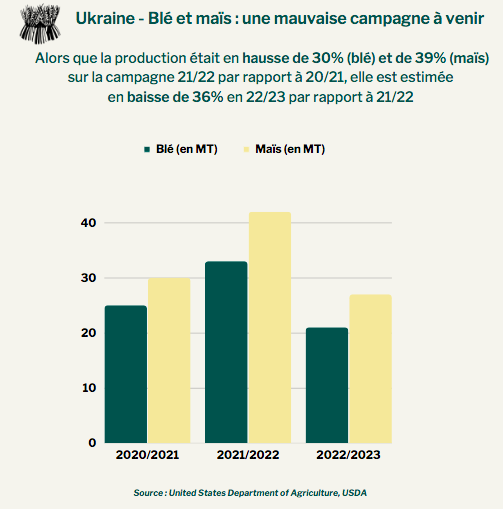
The uncertainty surrounding the corridor's renewal is compounded by a second uncertainty stemming from the conflict's lasting impact on Ukrainian grain production. Estimates[2] from the USDA for the 2022/23 campaign anticipates a decrease of 27 % in harvested areas, both in corn and in wheat. Given the assumptions in terms of returns, this would result in a 36% drop in corn and wheat production at the end of the campaign (i.e. -15 MT in corn and -12 MT in wheat). The conflict itself can make areas unsuitable for cultivation or harvesting, particularly for wheat grown in the east of the country. But the differential between production costs and domestic grain prices also strongly influences the areas sown. Thus, part of the corn area was left to dry on the stalk this winter due to the high cost of energy (making drying unprofitable), while excessively low domestic wheat prices have dissuaded Ukrainian producers from increasing their wheat areas to compensate for the areas lost in the east.
Agriculture in Ukraine: Review of destocking via the Black Sea corridor
Between the 1er Between August 2022 and January 31, 2023, 690 ships left the Black Sea ports, loaded with a total of 21 million tonnes (MT) of food products, mainly cereals and oilseeds. During this period, 10 MT of corn and 6 MT of wheat left Ukrainian ports[3]These figures are very close to the difference between the latest pre-conflict estimates of Ukrainian exports for the 2021/22 marketing year[4] and actual grain exports made in 2021/22.
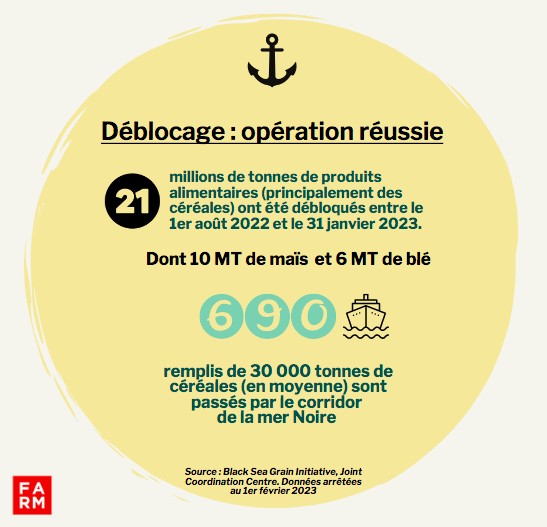
However, significant carryover stocks formed at the end of the campaign.[5], indicating that the two corridor initiatives, on the EU and Black Sea sides, were not sufficient to export all volumes on time.
Towards a sustainable reorganization of grain flows from Ukraine?
The conflict has significantly reshuffled the geography of Ukrainian markets for wheat and corn. The loss of access to the Black Sea initially led to a redirection exports towards land routes, mainly to the European Union. Between April and July 2022, 700,000 tonnes of wheat and 4.4 MT of corn were exported from Ukraine, i.e. 20 % and 50 % respectively of the average volumes exported over the same period of the last three campaigns[6]These volumes transited through the solidarity corridors which were set up by the European Union and whose capacities have gradually increased.
Between August and November 2022, the Black Sea Corridor enabled an increase in Ukrainian export capacity. Over these four months, 6.3 MT of wheat and 8.4 MT of corn were exported by Ukraine (all routes combined). For wheat, this represents a little over 50 % of the average volumes exported over the same period of the last three marketing years, a period which normally corresponds to the peak of exports. While the European Union was a minority destination of pre-war Ukrainian wheat exports, it represented 30 % of the volumes which transited through the Black Sea corridor between 1er August and January 31. Turkey has also been an important destination for Ukrainian wheat, with nearlyone million tonnes exported by sea over the same period. It should also be noted that Turkey is a major player in the processing of cereal products. It is the world's leading exporter of flour, and the Turkish president reiterated his determination to meet the needs of African countries dependent on Black Sea cereals.[7]
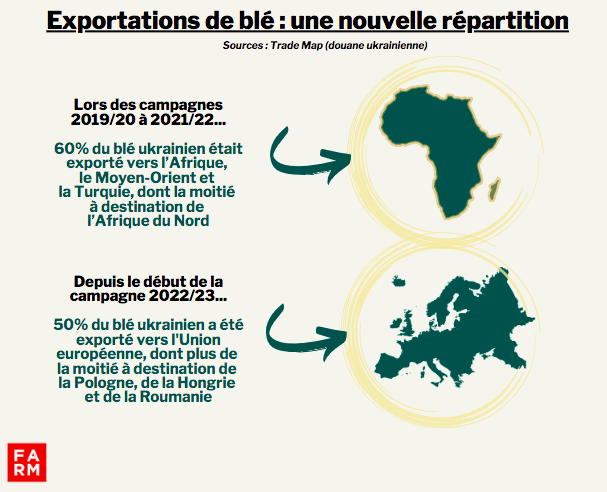
Between July and November 2022, the Middle East/Africa region accounted for only 20,130 tonnes of all wheat exports across all corridors, while it was the recipient of 51,130 tonnes of pre-war Ukrainian wheat volumes.[8]. Similarly, Asia (mainly South and Southeast) received only 8 % of Ukrainian wheat volumes against 36 % before the war.
So, it seems that a regionalization of Ukrainian grain exports. Overland transport routes remain heavily used in addition to maritime transport, and more complex flows are emerging. Of the total wheat exported by Ukraine between July and November 2022, more than a quarter reached its neighboring countries—Poland, Romania, and Hungary. Some of these volumes may have been re-exported, particularly from Turkey. In-depth analyses must be conducted to track Ukrainian grain and determine its final destination.
While the reopening of the Black Sea has only allowed a very partial resumption of shipments to Asia and Africa/Middle East, the stability of this new balance risks being questioned again in mid-March during negotiations around the renewal of the corridor. For the time being, wheat supplies to major importing countries remain assured by competing sources from Ukraine, including Russia and the European Union. While volumes are generally present today, price levels, still historically high, are having a heavy and lasting impact on economies and societies that are still struggling to recover from the pandemic.
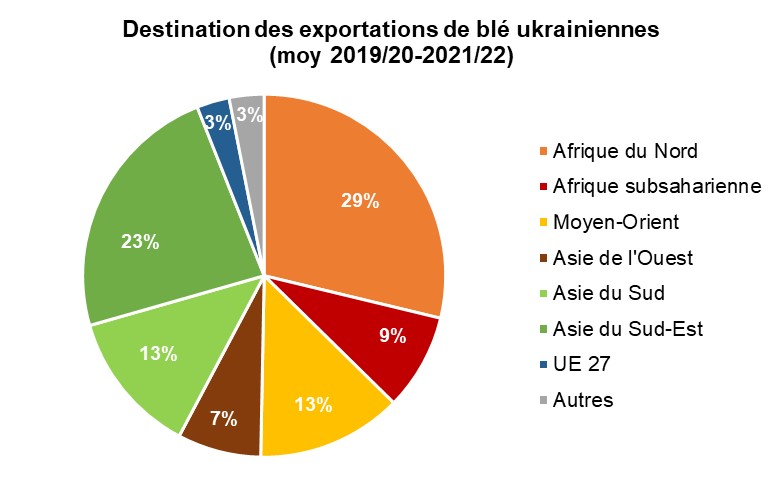
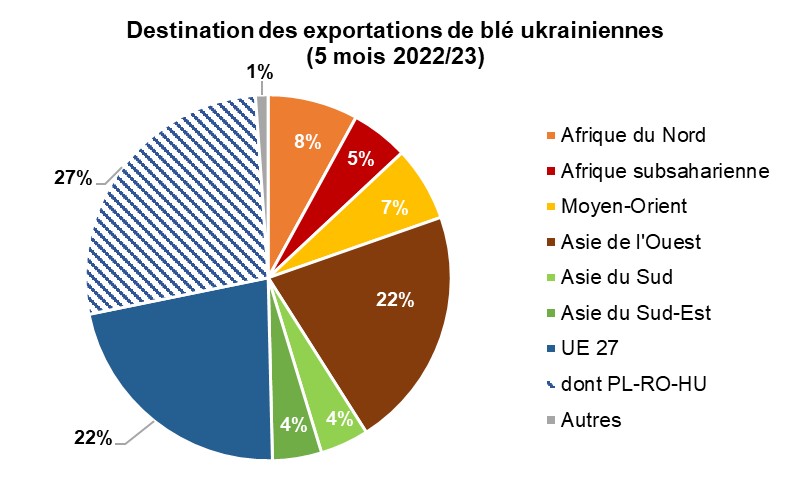
Sources FARM Foundation, according to Trade Map (Ukrainian customs)
[1] Source USDA, Food Balance Sheets of Ukraine
[2] Latest estimates as of January 2023, see the publication “Grain: World Markets and Trade”, dated January 12, 2023.
[3] Source Black Sea Grain Initiative, Joint Coordination Center; data as of 1er February 2023, are considered the departure dates of ships from the ports
[4] USDA, GAIN report, Grain and Feed Quarterly, Ukraine, Kyiv, January 31, 2022
[5] Around 5 MT of both corn and wheat, according to the USDA
[6] Source: Ukrainian Customs from Trade Map
[7] Recep Erdogan and Vladimir Putin have also agreed that the Russian wheat sent free of charge to Turkey should be processed before being sent to the African continent, as the article in La Tribune points out. Turkey "determined" to process Russian wheat for African markets. https://afrique.latribune.fr/economie/strategies/2023-01-09/la-turquie-determinee-a-transformer-le-ble-russe-a-destination-des-marches-africains-947204.html
[8] Source: Ukrainian customs according to Trade Map; the pre-war situation corresponds to the average market shares over the last three campaigns, from 2019/20 to 2021/22
